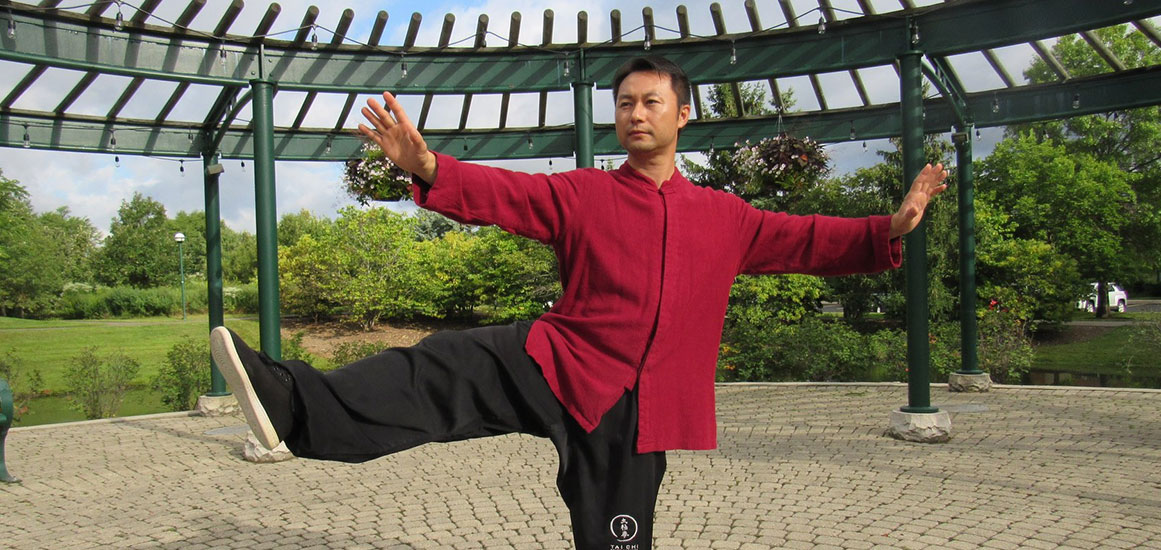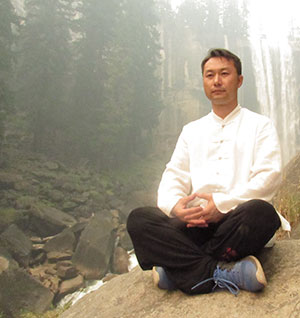
Wuji Martial Arts - Ken Ning

Wuji Martial Arts - Ken Ning
Ken Ning has been practicing martial arts for over 28 years and teaching martial arts and Tai Chi for over 14 years. The styles Ken has been practicing are Chin Na, Hung Ga, Lion Dance, Tai Chi Chuan (Taijiquan), Choy Lay Fut, Kickboxing, Boxing, Muay Thai Kickboxing, FMA, and Sanda (Full-Contact).
In 1990, Ken learned the Chinese military Chin Na from his uncle Liu Junquan. Chin Na is a Chinese martial art to control or lock an opponent's joints or muscles/tendons, so he cannot move, thus neutralizing the opponent's fighting ability.
In 1992, he practiced with Sifu PC Leung in Hung Ga Kung Fu and Lion Dance. Hung Ga is a southern Chinese martial art and was created from the southern shaolin styles. Hung Ga has deep low stances and strong hand techniques. The bridge hands and the versatile tiger claws are also the signature moves. In some traditionally training, students would spent months to three years in stance training, often sitting only in horse stance from half an hour to several hours at a time, before learning any forms.
In 1996, Ken started to practice Tai Chi with teacher Dale Washington. The focus was on the Tai Chi foot works, movements and applications.
In 1998, he’s learning Choy Lay Fut Kung Fu with Grand Master Sam Ng. It is a Chinese martial art and founded in 1836 by GM Chan Heung. Choy Lay Fut was named to honor his masters and the Shaolin roots of the system. This system combines the martial arts techniques from various Northern and Southern Chinese Kung-Fu systems. The powerful arm and hand techniques are combined with the extended and circular movements, twisting body, and agile footwork. Ken’s focusing on the practices of stances, foot work, forms, and ten element attacks. Also, he’s practicing Kickboxing with Sifu Philip Ng
In 1999, Ken’s training the Sanda (Full-Contact) with Sifu Philip Ng. Sanda is also known as Wushu Sanshou, Chinese boxing or Chinese kickboxing, is a Chinese Self-Defense system and combat sport. Sanda is a martial art which was originally developed by the Chinese military based upon the study and practices of traditional Kung Fu and modern combat fighting techniques; it combines full-contact kickboxing, it includes close range and rapid successive punches and kicks, with wrestling, takedowns, throws, sweeps, kick catches, elbow and knee strikes.
In 2000, he practiced Wu Style Tai Chi Chuan with Sifu Ban Toy. The study has been focusing on the Tai Chi philosophy, Meditation, Tai Chi Push Hands, foot works, and Tai Chi applications.
In 2002, Ken learned Boxing from Coach Edward Bitoy. The focus training was in foot works, conditionings, developing power, punching, punch combinations, and attacking strategies.
In 2006, he has been learning and practicing Yang Family Tai Chi Chuan directly under Grand Master Yang Jun. GM Yang Jun is the president and current 5th generation lineage holder of the International Yang Family Tai Chi Chuan Association. In 2017, Ken was selected and had the honor to become one of Grand Master Yang Jun's Disciples into the Yang Family Tai Chi Chuan inside circle. His Yang Family Disciple name is Yang Yazhe and it's given by his Shifu GM Yang Jun. Yang is the family name, and YaZhe means Elegant, Graceful and Wise. Sifu Guerman Atanassov is one of Ken’s Yang Family Tai Chi teachers.
In 2017, after the dedication of many years of practice and teaching martial arts, Ken Ning formed Wuji Martial Arts (WJMA).WJMA combined the core values of various martial arts together. It is focusing on how to use the body more efficient, apply martial art applications more effectively with least effort, accumulating more energy, and nurture the body.
Yang Family Tai Chi Chuan (Taijiquan):
The founder of the Yang Family Tai Chi Chuan was Great Grandmaster Yang Luchan (楊露禪), who studied under Chen Chang-Hsing (Chen Style Tai Chi Chuan grandmaster). The birthplace of Yang Style Tai Chi Chuan was in China, Hebei Province, Yongnian County. All the movements in the Yang Family Tai Chi Chuan have a purpose and martial art applications. About 180 years ago, Yang Luchan being hired by the Chinese Imperial Family to teach them and the Imperial Guards Tai Chi Chuan in Beijing Capital City.
The Yang Family Tai Chi movements are smooth, slow, even, graceful and extensive. The training focuses on foot work, stances, hand and body movements, qigong, hand forms, sword, saber, push hands and applications. Yang Family Tai Chi Chuan is a traditional Chinese internal martial art. It has been made to extend to be graceful, carefully structured, relaxed, gentle and flowing, while it still maintains the martial arts aspects. It’s a method for improving health and curing illness. Tai Chi Chuan is loved by millions of practitioners, spreading Tai Chi around the world. It has become the most popular of all Chinese martial arts, providing a remarkable contribution to the health of mankind.
Yang Luc han - 1st generation, Yang Jianhou - 2nd generation, Yang Chengfu - 3rd generation (large form) He standardized the form that is practiced throughout the world today. Yang Zhenduo – 4th generation and Yang Jun – 5th generation and he’s the current Yang Family Tai Chi Chuan linage holder.
han - 1st generation, Yang Jianhou - 2nd generation, Yang Chengfu - 3rd generation (large form) He standardized the form that is practiced throughout the world today. Yang Zhenduo – 4th generation and Yang Jun – 5th generation and he’s the current Yang Family Tai Chi Chuan linage holder.
 han - 1st generation, Yang Jianhou - 2nd generation, Yang Chengfu - 3rd generation (large form) He standardized the form that is practiced throughout the world today. Yang Zhenduo – 4th generation and Yang Jun – 5th generation and he’s the current Yang Family Tai Chi Chuan linage holder.
han - 1st generation, Yang Jianhou - 2nd generation, Yang Chengfu - 3rd generation (large form) He standardized the form that is practiced throughout the world today. Yang Zhenduo – 4th generation and Yang Jun – 5th generation and he’s the current Yang Family Tai Chi Chuan linage holder.Qigong is the effort of breathing. Qi (Chi) is air and or energy force. Gong (Kung) is an effort. Qigong is a traditional Chinese breathing and body exercise, and meditation for improve relaxation, health, self-awareness, and martial arts training. This practice is to develop, cultivate, accumulate, balance, and store qi for mind, body, and spirit.
Taoist and Buddhist believe Qigong and meditation help to access to higher realms of self-awareness for develop human potential.
Qigong practices involve sitting, standing, lying down, and moving meditations. It coordinates slow flowing movement, deep rhythmic breathing, and calm meditative state of mind. Qigong is now practiced throughout China and worldwide for recreation, exercise, relaxation, preventive medicine, self-healing, alternative medicine, meditation, self-cultivation, and training for martial arts.
Wuji Martial Arts:
Wuji (無極) means boundless, limitless, and infinite. Wuji Martial Arts (WJMA) is a system primary focusing on the core techniques of the Chinese traditional and modern martial arts together. Therefore, to achieve the martial art skills with discipline that requires patience, energy, hard work, and time. In Wuji Martial Arts, the focus training areas are the Yin and Yang philosophy, meditation, Qigong (breathing exercises), stances, foot work, balance movements, push hands, punching, kicking, elbows, knees, take downs, and self-defense techniques.
Wuji (無極) means boundless, limitless, and infinite. Wuji Martial Arts (WJMA) is a system primary focusing on the core techniques of the Chinese traditional and modern martial arts together. Therefore, to achieve the martial art skills with discipline that requires patience, energy, hard work, and time. In Wuji Martial Arts, the focus training areas are the Yin and Yang philosophy, meditation, Qigong (breathing exercises), stances, foot work, balance movements, push hands, punching, kicking, elbows, knees, take downs, and self-defense techniques.